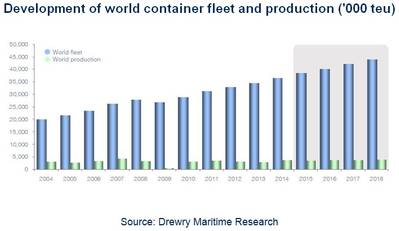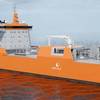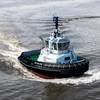Low material costs and stable demand has driven the price of new container equipment down to record lows where it is forecast to stay, according to the latest edition of the Container Census report published by global shipping consultancy Drewry.
The container equipment index price hit a 10-year low in June 2015, falling below $1,750 per CEU equivalent (or 20ft standard). The index fell sharply in late 2012 before stabilizing at just above $2,000 per teu throughout much of 2013-14, but has declined sharply this year.
“Much of the recent reduction resulted from a fall in material and production costs rather than any decline in demand or oversupply,” said Drewry’s lead analyst for container equipment Andrew Foxcroft. “Drewry is forecasting that the price index will, at best, hold at $1,800 per CEU for much of 2015-16, although it may go even lower.”
The global container equipment fleet amounted to 36.57 million teu at the end of 2014, having increased in size by 6.2 percent during 2014, which marked a small improvement over that of the preceding two years. The fleet is forecast to expand at an annualized rate of close to 5 percent through 2015 to 2018, in line with the continuing modest outlook for trade growth.
“Box fleet expansion will remain relatively weak because a growing share of the anticipated demand will be replacement purchases, while the outlook for global container shipping traffic is generally subdued,” Foxcroft added. “Drewry expects the leasing sector to hold on to its recently enhanced market share, even if shipping lines manage to increase their direct investment in new boxes, after several years of very poor fleet growth. The 40ft high-cube box will increasingly dominate within the global fleet.”
The leased fleet achieved another strong increase of 9 percent during 2014, as against 4 percent for that owned by shipping and other transport companies. This resulted in a yet another small gain for the box lease industry in terms of its fleet share, which by the end of 2014 was back to its level of exactly a decade earlier. Leasing companies are still well placed to raise capital for box equipment and this situation has already enhanced the fleet share owned collectively by companies based in the Americas, with losses experienced in recent years by their counterparts in Europe and in Asia.
The biggest numerical growth, over 10 percent, was calculated for the maritime 40ft high-cube fleet of principally dry freight and reefer containers, as against 5 percent for the 20ft counterpart. By the end of 2014 the 40ft high cube fleet accounted for the majority of all maritime equipment (in teu) for the first time.
“The outlook is for container supply to remain in relative balance with demand and for annual production to rise only modestly in the run-up to 2018,” Foxcroft concluded.











